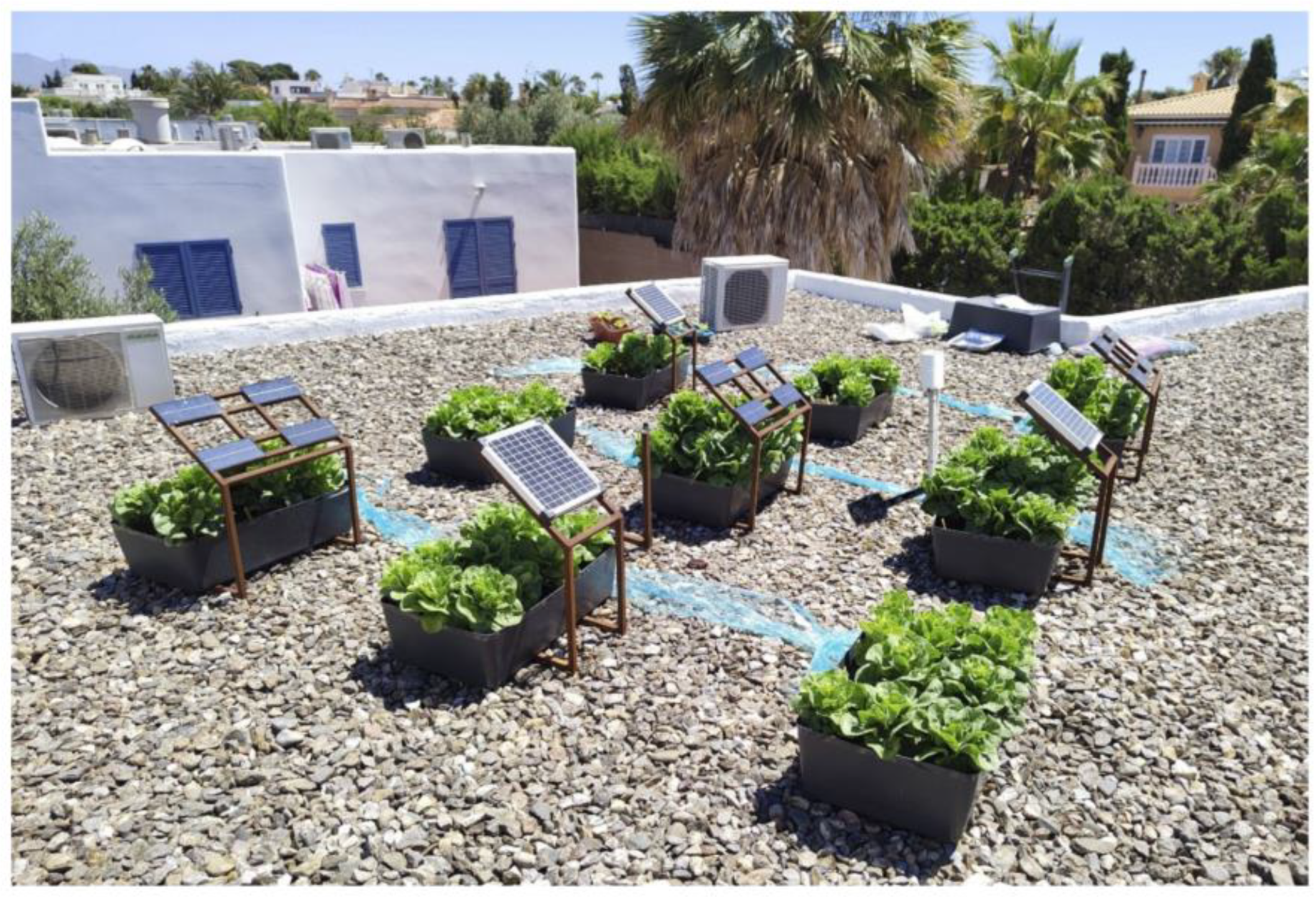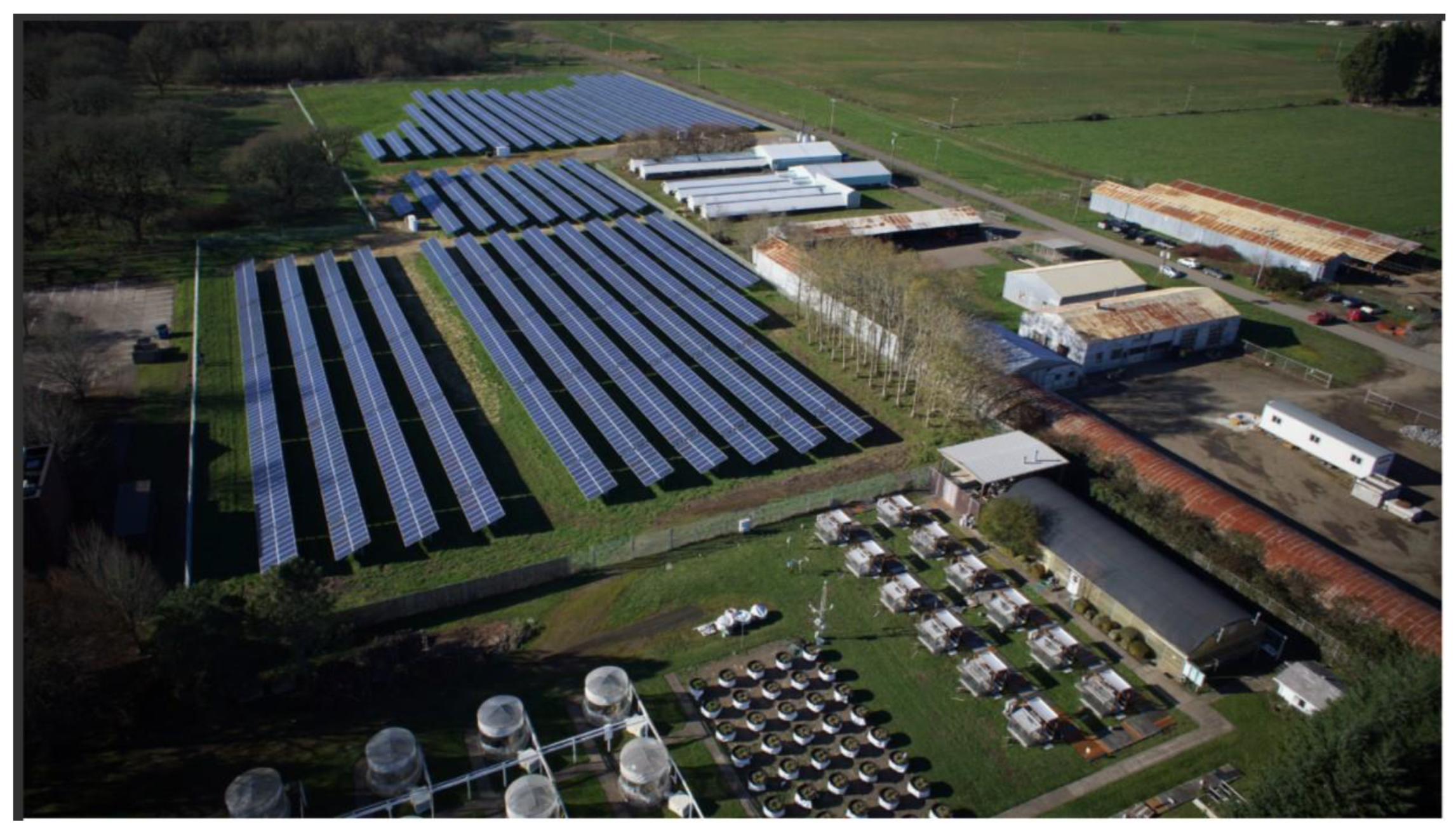
| Version | Summary | Created by | Modification | Content Size | Created at | Operation |
|---|---|---|---|---|---|---|
| 1 | Aritra Ghosh | -- | 1244 | 2022-09-09 10:12:06 | | | |
| 2 | Amina Yu | -7 word(s) | 1237 | 2022-09-09 10:34:15 | | | | |
| 3 | Aritra Ghosh | Meta information modification | 1237 | 2022-09-09 10:38:53 | | |
Video Upload Options
As more nations move towards net-zero emission goals by 2050, research into the coupling of photovoltaics (PV) and agriculture has increased into a new sector of agrivoltaics (AV). Measurement of the Land Equivalent Ratio (LER) has allowed researchers to develop methods for optimizing the agrivoltaic system. While AVs are seen as a method to reduce the land loss for traditional PV farms, research has shown that they can be both beneficial to crop growth and PV efficiency. The levels of photosynthetically active radiation (PAR) under the solar modules impact crop species in different ways. Understanding the PAR can be used to determine the most suitable crop to plant for each season. Factors such as micro-climates and water requirements are also changed due to the set-up of each AV system.
1. Land Use Optimization


2. Mutually Beneficial Relationship
3. Crop Production

Non-Commercial Crops
4. Micro-Climates
4.1. Water Usage

4.2. Increased PV Efficiency
References
- Bolinger, M.; Bolinger, G. Land Requirements for Utility-Scale PV: An Empirical Update on Power and Energy Density. IEEE J. Photovolt. 2022, 12, 589–594.
- Dias, L.; Gouveia, J.P.; Lourenço, P.; Seixas, J. Interplay between the potential of photovoltaic systems and agricultural land use. Land Use Policy 2018, 81, 725–735.
- Dinesh, H.; Pearce, J.M. The Potential of Agrivoltaic Systems. Renew. Sustain. Energy Rev. 2016, 54, 299–308.
- Beck, M.; Bopp, G.; Goetzberger, A.; Obergfell, T.; Reise, C.; Schindele, S. Combining PV and Food Crops to Agrophotovoltaic? Optimization of Orientation and Harvest. In Proceedings of the 27th European Photovoltaic Solar Energy Conference and Exhibition, EU PVSEC, Frankfurt, Germany, 24–28 September 2012.
- Goetzberger, A.; Zastrow, A. On the Coexistence of Solar-Energy Conversion and Plant Cultivation. Int. J. Sol. Energy 1982, 1, 55–69.
- Dupraz, C.; Marrou, H.; Talbot, G.; Dufour, L.; Nogier, A.; Ferard, Y. Combining solar photovoltaic panels and food crops for optimising land use: Towards new agrivoltaic schemes. Renew. Energy 2011, 36, 2725–2732.
- Riaz, M.H.; Imran, H.; Younas, R.; Butt, N.Z. The optimization of vertical bifacial photovoltaic farms for efficient agrivoltaic systems. Sol. Energy 2021, 230, 1004–1012.
- Imran, H.; Riaz, M.H. Investigating the potential of east/west vertical bifacial photovoltaic farm for agrivoltaic systems. J. Renew. Sustain. Energy 2021, 13, 033502.
- Imran, H.; Riaz, M.H.; Butt, N.Z. Optimization of Single-Axis Tracking of Photovoltaic Modules for Agrivoltaic Systems. In Proceedings of the 2020 47th IEEE Photovoltaic Specialists Conference (PVSC), Calgary, AB, Canada, 15 June–21 August 2020; IEEE: New York, NY, USA, 2020; pp. 1353–1356.
- Adeh, E.H.; Good, S.P.; Calaf, M.; Higgins, C.W. Solar PV Power Potential is Greatest Over Croplands. Sci. Rep. 2019, 9, 1–6.
- Al-Agele, H.A.; Nackley, L.; Higgins, C.W. A pathway for sustainable agriculture. Sustainability 2021, 13, 4328.
- Weselek, A.; Bauerle, A.; Zikeli, S.; Lewandowski, I.; Högy, P. Effects on Crop Development, Yields and Chemical Composition of Celeriac (Apium graveolens L. var. rapaceum) Cultivated Underneath an Agrivoltaic System. Agronomy 2021, 11, 733.
- Cos¸gun, A.E. The potential of Agrivoltaic systems in TURKEY. Energy Rep. 2021, 7, 105–111.
- Willockx, B.; Herteleer, B.; Cappelle, J. Theoretical potential of agrovoltaic systems in Europe: A preliminary study with winter wheat. In Proceedings of the Conference Record of the IEEE Photovoltaic Specialists Conference, Calgary, AB, Canada, 15 June–21 August 2020.
- Apostoleris, H.; Chiesa, M. High-concentration photovoltaics for dual-use with agriculture. In Proceedings of the AIP Conference Proceedings, Fes, Morocco, 25–27 March 2019; American Institute of Physics Inc.: College Park, MD, USA, 2019; Volume 2149.
- Marrou, H.; Wery, J.; Dufour, L.; Dupraz, C. Productivity and radiation use efficiency of lettuces grown in the partial shade of photovoltaic panels. Eur. J. Agron. 2013, 44, 54–66.
- Marrou, H.; Guilioni, L.; Dufour, L.; Dupraz, C.; Wery, J. Microclimate under agrivoltaic systems: Is crop growth rate af-fected in the partial shade of solar panels? Agric. For. Meteorol. 2013, 177, 117–132.
- Carreño-Ortega, A.; do Paço, T.A.; Díaz-Pérez, M.; Gómez-Galán, M. Lettuce Production under Mini-PV Modules Arranged in Patterned Designs. Agronomy 2021, 11, 2554.
- Kwon, O.H.; Lee, K.S. Agrophotovoltaic Designs: Irradiation Analysis on and under PV Modules. J. Korean Sol. Energy Soc. 2021, 41, 9–23.
- Cuppari, R.I.; Higgins, C.W.; Characklis, G.W. Agrivoltaics and weather risk: A diversification strategy for landowners. Appl. Energy 2021, 291, 116809.
- Barron-Gafford, G.A.; Pavao-Zuckerman, M.A.; Minor, R.L.; Sutter, L.F.; Barnett-Moreno, I.; Blackett, D.T.; Thompson, M.; Dimond, K.; Gerlak, A.K.; Nabhan, G.P.; et al. Agrivoltaics provide mutual benefits across the food-energy-water nexus in drylands. Nat. Sustain. 2019, 2, 848–855.
- Andrew, A.C.; Higgins, C.W.; Smallman, M.A.; Graham, M.; Ates, S. Herbage Yield, Lamb Growth and Foraging Behavior in Agrivoltaic Production System. Front. Sustain. Food Syst. 2021, 5, 659175.
- Lytle, W.; Meyer, T.K.; Tanikella, N.G.; Burnham, L.; Engel, J.; Schelly, C.; Pearce, J.M. Conceptual Design and Rationale for a New Agrivoltaics Concept: Pasture-Raised Rabbits and Solar Farming. J. Clean. Prod. 2020, 282, 124476.
- Graham, M.; Ates, S.; Melathopoulos, A.P.; Moldenke, A.R.; DeBano, S.J.; Best, L.R.; Higgins, C.W. Partial shading by solar panels delays bloom, increases floral abundance during the late-season for pollinators in a dryland, agrivoltaic ecosystem. Sci. Rep. 2021, 11, 1–13.
- Willockx, B.; Herteleer, B.; Cappelle, J. Combining photovoltaic modules and food crops: First agrovoltaic prototype in belgium. Renew. Energy Power Qual. J. 2020, 18, 266–271.
- Weselek, A.; Bauerle, A.; Zikeli, S.; Lewandowski, I.; Högy, P. Agrivoltaic system impacts on microclimate and yield of different crops within an organic crop rotation in a temperate climate. Agron. Sustain. Dev. 2021, 41, 59.
- Weselek, A.; Ehmann, A.; Zikeli, S.; Lewandowski, I.; Schindele, S.; Högy, P. Agrophotovoltaic systems: Applications, challenges, and opportunities. A review. Agron. Sustain. Dev. 2019, 39, 35.
- Moreda, G.P.; Muñoz-García, M.A.; Alonso-García, M.C.; Hernández-Callejo, L. Techno-economic viability of agro-photovoltaic irrigated arable lands in the eu-med region: A case-study in southwestern spain. Agronomy 2021, 11, 593.
- Hassanpour Adeh, E.; Selker, J.S.; Higgins, C.W. Remarkable agrivoltaic influence on soil moisture, micrometeorology and water-use efficiency. PLoS ONE 2018, 13, e0203256.
- Dubey, S.; Sarvaiya, J.N.; Seshadri, B. Temperature Dependent Photovoltaic (PV) Efficiency and Its Effect on PV Production in the World—A Review. Energy Procedia 2013, 33, 311–321.
- Othman, N.F.; Yap, S.; Ya’Acob, M.E.; Hizam, H.; Su, A.S.; Iskandar, N. Performance evaluation for agrovoltaic DC generation in tropical climatic conditions. AIP Conf. Proc. 2019, 2129, 020006.
- Kumpanalaisatit, M.; Setthapun, W.; Sintuya, H.; Jansri, S.N. Efficiency improvement of ground-mounted solar power generation in agrivoltaic system by cultivation of bok choy (Brassica rapa subsp. chinensis L.) under the panels. Int. J. Renew. Energy Dev. 2021, 11, 103–110.




